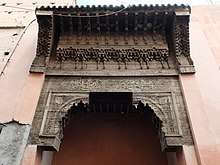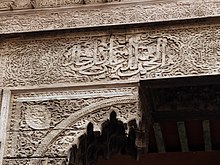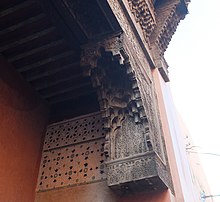Shrob ou shouf fountain
The Shrob ou shouf fountain (also spelled Chrob ou chouf)[1] is a historic wall fountain in the medina of Marrakech, Morocco. It dates from the late 16th or early 17th century and is located near the Ben Youssef Madrasa.
| Shrob ou shouf fountain | |
|---|---|
 | |
| Type | Fountain |
| Coordinates | 31°38′0.6″N 7°59′15.7″W |
| Area | Marrakesh, Morocco |
| Built | late 16th or early 17th century |
| Architectural style(s) | Saadian, Moroccan, Islamic |
Historical background
_(14592859987).jpg)
The fountain was erected during the Saadian dynasty period, when Marrakesh was the capital of Morocco, and closely resembles other Saadian fountains in style (e.g. the fountains of the Mouassine Mosque and Bab Doukkala Mosque).[2][3]:461 Although the date and founder of the structure is not directly identified, some attribute the fountain to the reign of Sultan Ahmad al-Mansur (1578-1603).[4]
The name of the fountain today means "drink and look" in Moroccan Arabic (implying that one should admire the fountain as well as use it).[4]
Description
The fountain consists of a simple loggia or large alcove sheltering an access to water. Old photographs show that the loggia was once deeper and included a basin for the water at the base of the innermost wall, while a wooden bar across its entrance prevented animals (e.g. donkeys, horses) from drinking the same water as humans.[2] At some point in modern times, however, the space appears to have been modified or partially filled in (the back wall was probably moved forward), so that today the loggia seems to be shallower than it was and some of these elements (like the basin ) have disappeared.[2]
The lower part of the fountain, at ground level, is plain and features no (surviving) decoration. Above, however, the fountain is sheltered by a canopy of finely carved palm wood in a typical Moroccan-Andalusian (or Moorish) style.[2] Much of the canopy's surface is carved with arabesque patterns and many of its elements are carved into muqarnas ("honeycomb"-style sculptures). The form and decoration of the canopy is particularly similar to that of other Saadian wall fountains of the period (e.g. those of the Mouassine and Bab Doukkala mosques), as well as the carved wooden canopies of the Saadian Tombs and of the Saadian pavilions in the courtyard of the Qarawiyyin Mosque. The spandrels of the wooden arch feature a mandorla-type (or almond-shaped) motif which may be of Ottoman influence.[2] Carved into the lintel are two cartouches containing Arabic calligraphic inscriptions in thuluth style, with verses praising God: "The most beautiful words that have been said are: praise to God in all circumstances!" (approximate translation).[2] The same verses are also found on the lintels of the fountains of the Mouassine and Bab Doukkala mosques from the same period. Above the lintel, the wooden canopy culminates in a wide parapet projecting over the street, the top of which is roofed with green tiles.
References
| Wikimedia Commons has media related to Chrob ou chouf fountain. |
- "Shrob ou Shouf Fountain". Archnet. Retrieved 2020-06-16.
- Salmon, Xavier (2016). Marrakech: Splendeurs saadiennes: 1550-1650. Paris: LienArt. pp. 70, 120–121, 128–129.
- Deverdun, Gaston (1959). Marrakech: Des origines à 1912. Rabat: Éditions Techniques Nord-Africaines.
- "LA FONTAINE CHROB OU CHOUF". Retrieved May 10, 2019.

